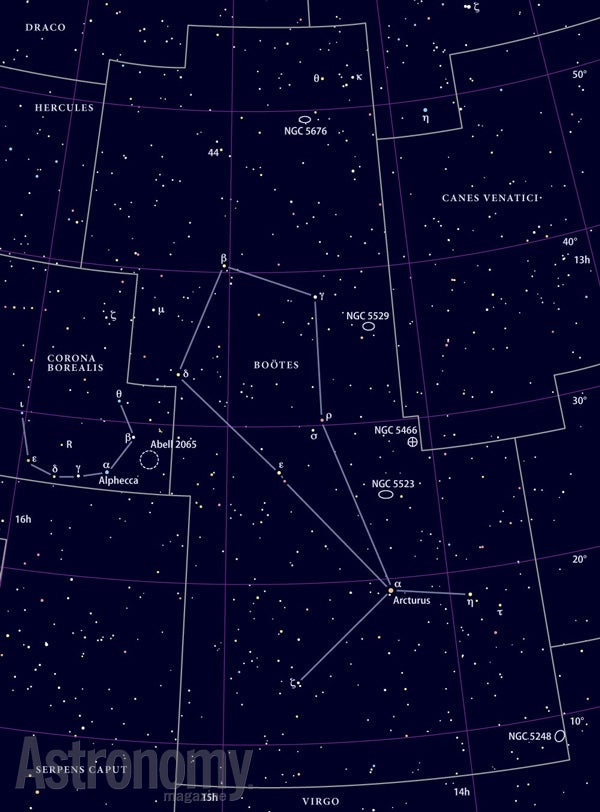Targets for April 23–30, 2015
Small telescope:
Centaurus A (NGC 5128)
Large telescope:
Spiral galaxy M101
Large telescope:
Spiral galaxy NGC 5248
This week’s small-telescope target is peculiar galaxy Centaurus A, also known as NGC 5128, Caldwell 77, and the Hamburger Galaxy. You’ll find it 3.5° west of magnitude 3.5 Mu (μ) Centauri.
Seeing Centaurus A high in the sky is one of the thrills of Southern Hemisphere observing. Observers call it the Hamburger Galaxy because two stellar regions (the bun) surround a dark dusty lane (the burger). Unfortunately, most northern viewers get only a taste of this object’s details. For example, from Tucson, Arizona, NGC 5128 climbs to a maximum altitude of 15°.
Viewing any object through that much of Earth’s atmosphere presents a distorted view. For better results, head farther south.
Australian astronomer James Dunlop discovered NGC 5128 in 1826 and published the observation within a list of 629 objects titled “A catalogue of nebulae and clusters of stars in the southern hemisphere, observed at Parramatta in New South Wales,” which appeared in Volume 118 of the Philosophical Transactions of the Royal Society in 1828.
NGC 5128’s appearance arises from a galactic collision. The main body of Centaurus A — a giant elliptical galaxy — is absorbing a smaller spiral galaxy.
The two objects collided more than 200 million years ago, causing huge bouts of star formation.
Through small telescopes, NGC 5128 appears round with a wide, dark lane cutting the galaxy in half. Note that this galaxy appears bright and large. It shines at near-naked-eye magnitude 6.7 and measures 31.0′ by 23.0′. That means it covers 94 percent as much area as the Full Moon.
Using a 12-inch or larger scope, you’ll see a thin wedge of light shining through the lane’s western end. That lane widens on both ends.
Faint, but fabulous
This week’s first large-scope object is spiral galaxy M101 in Ursa Major the Great Bear.
To get a rough idea of the position of M101, make an equilateral triangle with the two stars at the end of the Big Dipper’s handle. Alternatively, it lies 1.5° east-northeast of the magnitude 5.7 star 86 Ursae Majoris.
Only one thing prevents spiral galaxy M101 from making every observer’s top 10 list — its low surface brightness. That number combines M101’s relatively bright overall magnitude — 7.9 — with its unusually large diameter of 26′. Covering 89 percent as much area as the Full Moon, M101’s light spreads out so much that only large amateur telescopes (those 12 inches and larger in aperture) do it justice.
M101 represents one of the sky’s “grand design” spiral galaxies — one with prominent and clearly defined spiral arms. Usually, the arms mostly or completely surround such galaxies. Only about 10 percent of all spiral galaxies fall into the grand design category.
From a dark site through a 12-inch telescope, look for M101’s multiple spiral arms. Its core is concentrated but broad, not starlike. Many star-forming regions and stellar associations lie along the spiral arms. In fact, at least five are bright enough to have their own NGC numbers: NGC 5447, NGC 5455, NGC 5461, NGC 5462, and NGC 5471. Of these, NGC 5447 is the most prominent. Find it 6′ southwest of M101’s core.
Several other objects within M101 once carried similar designations, but astronomers no longer officially recognize them. Use a nebula filter to tell the difference between star-forming regions and associations. The filter will dim the stars within the associations, but not the nebular gas of the star-forming regions.
Admiral William Smyth, writing in his 1844 classic Cycle of Celestial Objects, said of M101, “It is one of those globular nebulae that seem to be caused by a vast agglomeration of stars, rather than by a mass of diffused luminous matter; and though the idea of too dense a crowd may intrude, yet the paleness tells of its inconceivable distance, and probable discreteness.”
Small target in Boötes
This week’s second large-telescope target is spiral galaxy NGC 5248 in Boötes the Herdsman. Observers also know it as Caldwell 45. It lies in a relatively barren region of sky deep in the constellation’s southwestern corner, 8.9° east-southeast of magnitude 2.9 Vindemiatrix (Epsilon [ε] Virginis).
The galaxy glows at magnitude 10.3 and measures 6.2′ by 4.6′.
Even through a 4-inch telescope, you’ll notice the bright core, but you’ll need a larger instrument to pull out any details around it.
Through a 10-inch or larger scope at magnifications above 200x, you can pick out the galaxy’s short spiral arms. Each contains a much brighter region of star formation that appears as a curved line.
Through a 14-inch instrument, challenge yourself to look for two 15th-magnitude satellite galaxies of NGC 5248. UGC 8575 sits 0.5 west of the main object, and UGC 8629 lies 0.5 to the southeast.
Expand your observing at Astronomy.com
StarDome
Check out Astronomy.com’s interactive StarDome to see an accurate map of your sky. This tool will help you locate this week’s targets.
The Sky this Week
Get a daily digest of celestial events coming soon to a sky near you.
Observing Talk
After you listen to the podcast and try to find the objects, be sure to share your observing experience with us by leaving a comment at the blog or in the Reader Forums.











